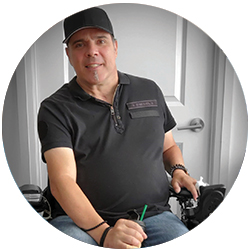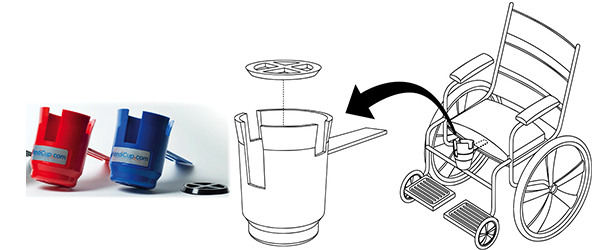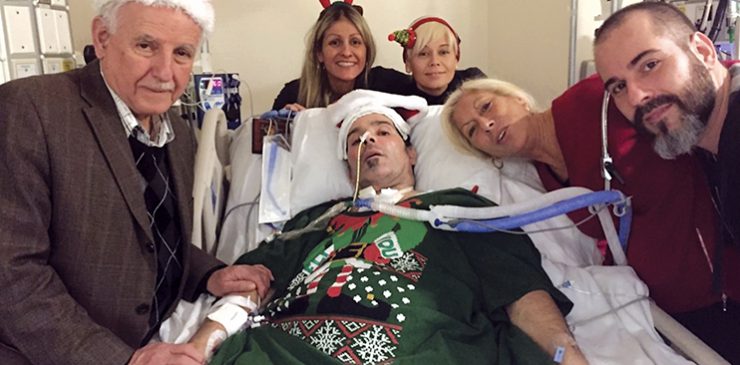He struggled to get up but couldn’t move his legs and arms. His fingers felt as weak as wet noodles. Chris started calling for help knowing that it was next to impossible for someone to hear him on the other side of the wall in his condo building. But he kept on calling and hoping that someone, somehow would come looking for him.
The confined space in the tub made his upper body fold inward and his airway was constricted. His body was becoming toxic as he couldn’t exhale carbon dioxide due to a collapsed lung. Being a wrestler back in high school, he knew a few tricks to breathe better by straightening his neck and keeping the air way open. Finally, he stopped calling as he needed that last bit of energy to keep breathing. . . for the next 15 hours.
His salvation came from the very same source that gave him life in the first place. The night before, Chris was at his mother Toni’s home and, unknowingly to both, he forgot his cellphone at her place. When he failed to show up at work after 9 the next morning, his cellphone rang. Toni answered the phone and told them that she would check on Chris. At first, she didn’t think it was a big deal, so by the time she arrived at Chris’ condo, it was already 1 in the afternoon.

Thinking Chris was not home, she asked the concierge to open his unit, which he did, but the chain was still on the door. Terror set in, Toni realized something was very wrong. “CHRIS!” She called at the top of her lungs. With a hollow voice, Chris responded, “help, help.” All his life, she had never heard him call for help. She demanded the concierge to cut the chain off, but the concierge insisted that he had to call the police first. Being a determined and strong-minded woman, Toni kicked the door open. When Chris heard his mom’s voice, he relaxed his neck thinking that he was found. His air immediately cut off and he passed out. When Toni finally reached him, his lips turned blue and his eyes rolled to the back of his head. It was a horrific scene for a mother to witness.
The next thing Chris remembered was lying inside an ambulance on his way to a local hospital. He was fully conscious and was able to talk and answer all the questions asked by the paramedics. Without any obvious signs of trauma, the initial assessment couldn’t determine the nature of Chris’ injury. Many hours were wasted on the road, during which he was turned away by two local hospitals that weren’t fully equipped. Finally, a paramedic asked Chris if he felt a finger in his rectum, a method used to quickly find out if someone has a spinal cord injury. “What?! NO!” That’s when Chris first realized the severity of his situation. It changed everything and now it was confirmed that he should be sent to Toronto Western, one of the few hospitals with an SCI trauma unit.
By the time he arrived at Toronto Western, it was about 10 pm. He had developed a pressure sore on his tail bone by lying too long on the hard wood stretcher. He was sent straight into Emergency and had a decompression surgery on his C5-C6.
For the next four months, Chris was in ICU with an incubator. He suffered pneumonia, a heart attack and a rejection to a blood transfusion. His family had been told several times that he may not be able to make it. Even if he did, he would never move his arms, breathe on his own, eat solid food, drink or talk. His families and extended families were all there for him. He always had someone at his bedside. They held prayer vigils every night, where they experienced peace and hope beyond understanding.

With the help of a wonderful team of respiratory therapists, Chris finally got off the ventilator before being released from ICU. He stayed another three months at Toronto Western until rehab. He came to Lyndhurst in Toronto with high hopes, believing that he would eventually walk again. But before long, he realized that his disability was permanent. There was a lot of crying during that time. He started to drop his head down and kept looking at the floor as he wheeled around. He didn’t want to make eye contact with anyone. He wanted to be depressed alone. The only peer support he wanted to receive was from an old friend in high school named Flavio. Flavio learned about Chris’s injury via Facebook. When Flavio came to visit him, Chris was encouraged to see how agile, positive and confident Flavio was. He shared his feelings openly and asked a lot of dark questions. Another person that inspired him was Rick Hansen who works with Chris’ sister. He came to visit him several times in the ICU, at Lyndhurst and in the community. Rick’s accomplishment gave Chris hope that there is still life after spinal cord injury.
Life after injury officially started when Chris moved to his new apartment. On that first day, when the door closed behind him and he was alone between four white walls, he was overwhelmed by a lot of emotions. He remembers thinking, “Chris what are you going to do now? Are you going to wilt, are you going to stay in your room and watch TV all day, or are you going to try doing something?” Prior to his injury, he was a very social person with a huge circle of friends. But by the time he returned to the community, most of them had already faded away. The new friends he made were very supportive. They gave without expecting anything in return. With their help, he slowly achieved his new normal.

One summer day in 2016, he decided to go on an adventure to Yorkdale mall by wheeling there. After 1.5 hours under the glazing sun, he arrived at Yorkdale and went straight to the client services desk asking for an ice pack for his head and a cup of cold water to drink. After that ordeal, he realized he needed to find a way to be able to pick up a drink with his limited hand function. He started brainstorming, designing, creating prototype, finding a 3-D printer, presenting his design, applying for patent and launching his product. And that was the birth of Handicup, a universal cup holder attaching to the front of any wheelchairs. Now he has his company Handihelp providing other products and services for people in the disability community.
As Chris reflected upon his journey, he said, “I felt so fragile and small at the time of my initial stage. I was so fortunate to have my families by my side at all time. And all of my therapists, nurses and doctors at Lyndhurst were so good at what they are doing. My physio Jamie Young believed in me more than I believed in myself. Though my challenges at the time were insurmountable, the reality is that amazing things and huge things were still possible ahead of me. I want to use my experience to encourage others. I want to show them that it gets better when they try. If you engage life, life engages you.”

Chris volunteers at UHN as a patient partner. He sits on the TTC accessible advisory council. He just finished the Rick Hansen Foundation assessor certification at George Brown College, which allows him to audit private and public buildings for their accessibility. He is also on the Young Professionals Board at Spinal Cord Injury Ontario. He completed his first 5k last year and plans to do it again this year. If you’d like to learn more about Chris’ company you can visit the Handicup website or the Handihelp site.











